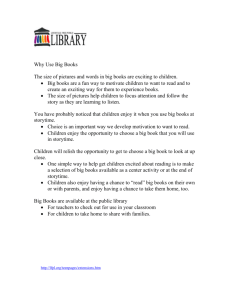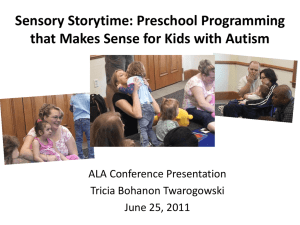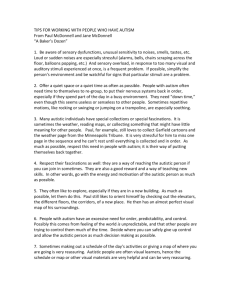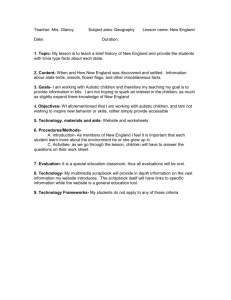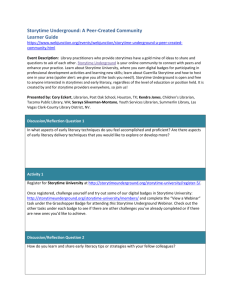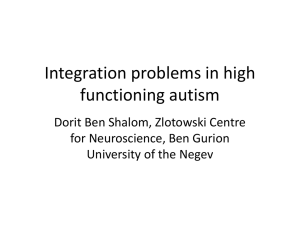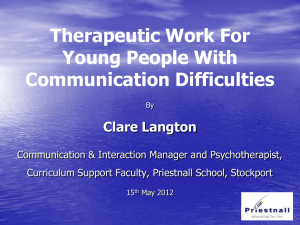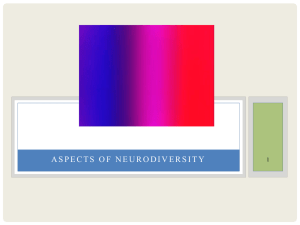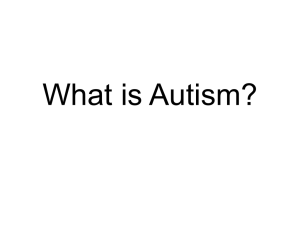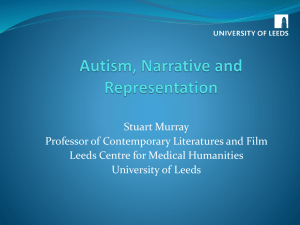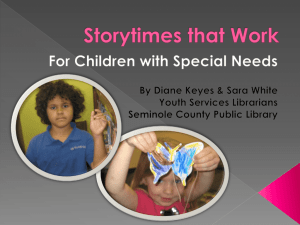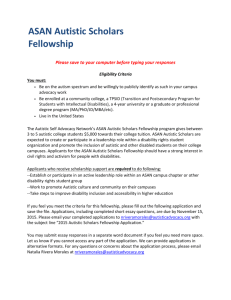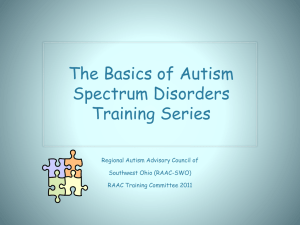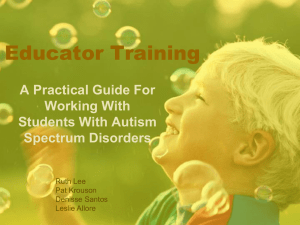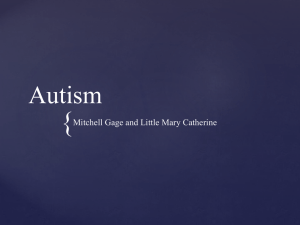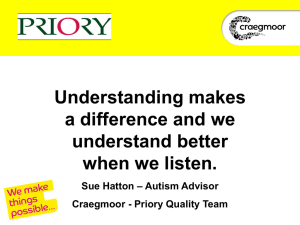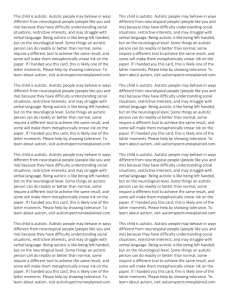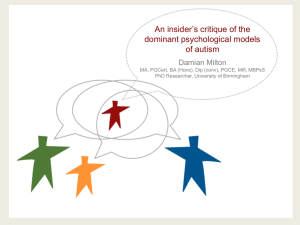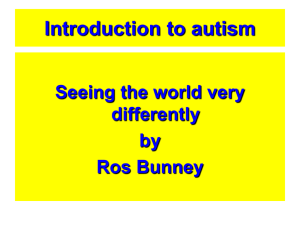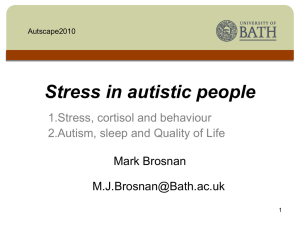Sensory Storytime.ppt
advertisement
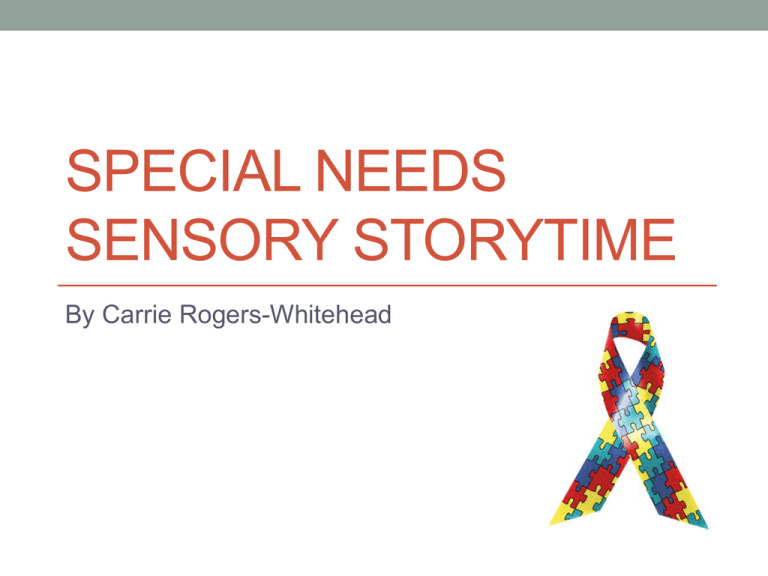
SPECIAL NEEDS SENSORY STORYTIME By Carrie Rogers-Whitehead WHY DO THIS TYPE OF STORYTIME? Liam, his brother and mother “I have never had the ability to take my 4 year old to story time because I can't bring her older brother even to the library let alone story time. She loved story time today and it was so nice to be able to see her enjoying the program so much and not have to worry about my son and having to grab her and leave because of his behavior. I have searched and searched and have not found any other programs for the more severely affected kids out there whatsoever.”--Monica Carpenter, parent of an autistic boy WE’RE NUMBER ONE The most recent statistics have found that Utah has the NUMBER ONE highest rate of autism in children in the country. Utah number one in autism cases WHAT IS AUTISM SPECTRUM DISORDER? http://carlysvoice.com/home/carly-in-the-media/ Carly’s voice video It is sometimes said that if you know ONE person with autism, you know ONE person with autism. The Autistic Brain How different parts of the brain are affected • Amygdala • Cerebellum • Hippocampus • Corpus Collosum • Frontal lobe Autism is a Sensory Processing Disorder “Self regulation is the nervous system’s ability to attain, maintain and change levels of arousal or alertness.” (Williams and Shellenberger, 1994) Sensory Seeking vs. Sensory Aversion Under Responsive Over-responsive General Impairments 1. Communication 2. Social Interactions 3. Socially irrelevant behaviors Autistic people create OUTPUT to prevent INPUT Autistic people SYSTEMIZE rather than EMPATHIZE” HOW IS THIS TYPE OF STORYTIME DIFFERENT? SIMILARITIES Songs Stories Visuals Format Audience But there are differences… Board Maker Autistic children are very visual and often use picture symbols to designate activities and abstract concepts. Different types of books Simple, repetitive text As literal as possible Toddler books are great Always have a visual to go with your book or some kind of physical activity Try books that you sing instead of read Use BIG books Autistic Children are visual learners Double visuals Let the children help tell the story. Visual Learning: Space Visually demarcate “your” space vs. “their” space Understand that many children cannot sit and will move. Do not restrict this Are many of these children sitting? Proprioception: sensing the orientation and motion of ones limb’s and body through space Proprioception contd. Weighted blankets and fidget toys are a great way to calm sensory seeking behavior. Visual Learning: No Distractions Hide program supplies in a basket next to you Put away any wires for CD players or other electronic equipment Hide craft supplies with tablecloth Put away any other items, display cases, flags, decorations, pull blinds away Digital projectors etc. not recommended No Distractions (contd) Dim the lights (optional) Keep door closed to prevent escape artists If possible put a volunteer near the back of the room near the door to control outbursts etc. Provide earplugs to sound-sensitive children No Distractions (contd) Have parents sit with their children. Do not provide chairs unless necessary. Managing Behavior Follow the 8 to 2 rule Let parents be the ones who discipline, it is not your role Show children visually what you want them to do Praise good behavior Have other children model proper behavior, the other children will see it and follow Songs Autistic children love songs! Include more songs than your regular storytime Make songs tactile through scarves, ribbons, beanbags, parachutes, shakers or anything else you can think of Making “snow” with a parachute during a song. Rest Area Include a space in your storytime room/auditorium for the children to take a break Put related books and stuffed animals in this area A rest area can be great for upset children, do not call it “Time out” Having a rest area lets the children and parents participate without having to leave the room Crafts Adapt your regular storytime crafts to ones that are more tactile and less complicated Playtime/ Social Hour Always leave time afterwards for the kids to run around and play. Parents also want a time to socialize and meet with other parents that have autistic children. My autistic children LOVE the bubbles and play time. I always play music afterwards too. Marketing and Outreach More Tips: Research Outreach Be adaptable Treat autistic children differently than the children in your regular group Repetition An e-mail group is a must Consistency Libraries are spaces for EVERYONE Myself with Christa, Liam’s mom about year after starting the Sensory Storytime. Resources to check out Tricia’s blog on her autistic storytime on ALSC: http://www.alsc.ala.org/blog/?p=536 1001 Great Ideas for Teaching and Raising Children with Autism for Asperger’s by Ellen Notbohm Utah Parent Center: http://www.utahparentcenter.org/ Autism Speaks: http://www.autismspeaks.org/ Boardmaker Share: Find great picture symbols for your storytime for free. http://www.boardmakershare.com/ Your local Special Ed teachers. Find some here: http://www.schools.utah.gov/sars/ If you have any questions or are interested in starting your own storytime for autistic children. Please contact Carrie RogersWhitehead at 801-944-7611 or crwhitehead@slcolibrary.org
